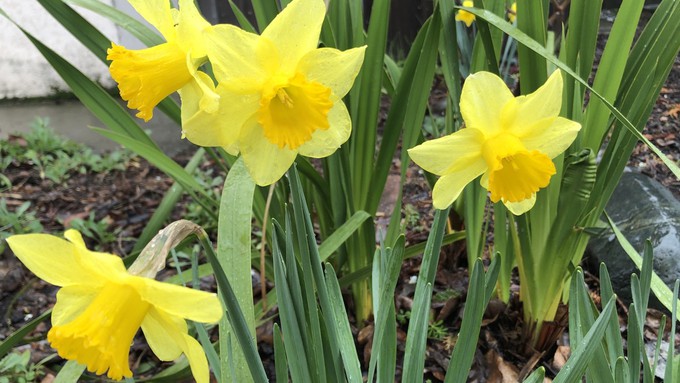
Weather service says 'expect substantial disruptions to daily life'

Daffodils are hanging in there, despite all the cold and wet weather. More is coming our way this weekend. Kathy Morrison
Our wet – and cold – winter continues. After a brief sunny break, more storms will roll through the Sacramento Valley this weekend on their way to the Sierra, creating very snowy and dangerous conditions, says the National Weather Service.
“Expect SUBSTANTIAL disruptions to daily life this weekend as another strong winter storm brings more heavy snow to the mountains & foothills with extensive travel impacts,” tweeted the NWS Sacramento office on Friday morning. (All-caps emphasis is theirs.) “Get all your traveling done by (Friday night) because conditions will deteriorate starting early Saturday!”
This storm will affect the foothills as well as the peaks. Snow is forecast as low as 1,500-foot elevation. Blizzard conditions are expected in the Sierra passes as well as lower elevations.
“Please reconsider your mountain travel plans this weekend!!!” said the weather service in another Friday morning tweet. “Heavy snow & gusty winds will bring DANGEROUS to IMPOSSIBLE travel conditions Saturday-Monday. Mountain travel is HIGHLY discouraged, but if you are thinking of driving up there, ask yourself these questions!”
The first question: “Do I have enough supplies and an emergency kit if I get stranded?”
In the Valley, the concern will be more rain and wind, not snow. The current forecast calls for one-half to one inch of rain in Sacramento, spread out over Saturday through Monday, with 20 mph winds and gusts up to 30 mph. That’s enough to knock over already-wobbly trees. More rain is expected throughout the week.
Besides the rain, the current weather pattern is much colder than normal. Sacramento’s average high temperature for this week: 66 degrees. The forecast high for this weekend: 52 degrees. Overnight lows will be down in the 30s, too. That follows a frosty trend; Sacramento set record lows – 35 degrees – for March 1 and 2.
That kind of cold can put the brakes on spring bulbs and other March flowers as well as kill tender new growth.
On the bright side, our water picture looks very good for spring and summer. Rain on the final six days of February brought that month’s total to 2.56 inches for Downtown Sacramento – more than an inch below normal. But thanks to a very wet December and January, our water year is still tracking above average.
Since Oct. 1 (the start of our “rainy season”), Sacramento has received 20.78 inches – more than 7 inches above normal for those five months. A “normal” rain year (October-September) for Sacramento totals about 17.6 inches.
For more on local weather including storm timelines: https://www.weather.gov/sto/#.
Comments
0 comments have been posted.Sacramento Digs Gardening to your inbox.
Food in My Back Yard Series
May 6: Maintain soil moisture with mulch for garden success
April 29: What's (already) wrong with my tomato plants?
April 22: Should you stock up on fertilizer? (Yes!)
April 15: Grow culinary herbs in containers
April 8: When to plant summer vegetables
April 1: Don't be fooled by these garden myths
March 25: Fertilizer tips: How to 'feed' your vegetables for healthy growth
March 18: Time to give vegetable seedlings some more space
March 11: Ways to win the fight against weeds
March 4: Potatoes from the garden
Feb. 25: Plant a fruit tree now -- for later
Feb. 18: How to squeeze more food into less space
Feb. 11: When to plant? Consider staggering your transplants
Feb. 4: Starting in seed starting
Sites We Like
Garden Checklist for week of May 11
Make the most of the lower temperatures early in the week. We’ll be back in the 80s by Thursday.
* Plant, plant, plant! It’s prime planting season in the Sacramento area. Time to set out those tomato transplants along with peppers and eggplants. Pinch off any flowers on new transplants to make them concentrate on establishing roots instead of setting premature fruit.
* Direct-seed melons, cucumbers, summer squash, corn, radishes, pumpkins and annual herbs such as basil.
* Harvest cabbage, lettuce, peas and green onions.
* In the flower garden, direct-seed sunflowers, cosmos, salvia, zinnias, marigolds, celosia and asters. (You also can transplant seedlings for many of the same flowers.)
* Plant dahlia tubers.
* Transplant petunias, marigolds and perennial flowers such as astilbe, columbine, coneflowers, coreopsis, dahlias, rudbeckia and verbena.
* Keep an eye out for slugs, snails, earwigs and aphids that want to dine on tender new growth.
* Feed summer bloomers with a balanced fertilizer.
* For continued bloom, cut off spent flowers on roses as well as other flowering plants.
* Add mulch to the garden to maintain moisture. Mulch also cuts down on weeds. But don’t let it mound around the stems or trunks of trees or shrubs. Leave about a 6-inch-to-1-foot circle to avoid crown rot or other problems.
* Remember to weed! Pull those nasties before they set seed.
* Water early in the day and keep seedlings evenly moist.